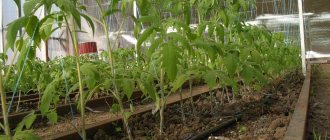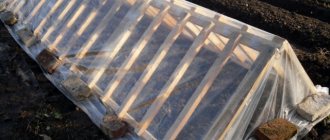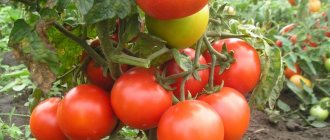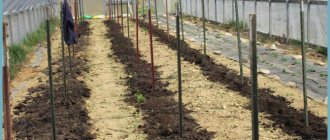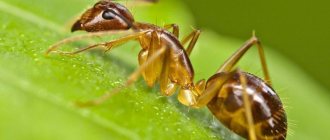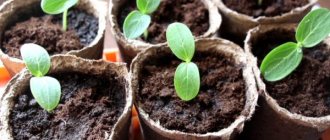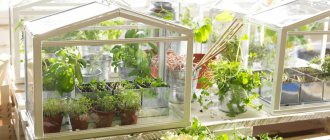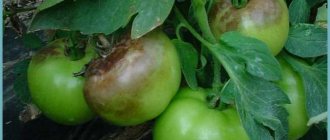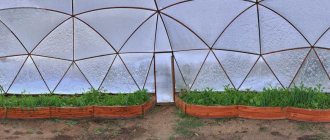What kind of lunar calendar is this?
To begin with, many greenhouse owners rely on the lunar calendar when planning to plant tomatoes. Its main feature is that nature has its own “favorable” days for planting seedlings in each new season.
But, if you are not guided by such manuals, plan the preparation and planting of seeds so that the finished seedlings are taken to the greenhouse at the right time. And the seedling period of greenhouse tomatoes is from 45 to 65 days, and in unheated greenhouses they are planted on the 15th-20th of March.
Main stages
Each stage of cultivation requires proper care and compliance with the necessary conditions inside the greenhouse.
Before flowering.
12 days after planting the seedlings under the greenhouse, it is necessary to tie the plants to the trellis. Most often, tomato bushes are formed into one stem, removing all the stepsons growing from the axils of the leaves and roots, leaving only one lower stepchild with a flower raceme. Before the flowering stage begins, tomatoes are watered every six days, using five liters of water per square meter of planting.- During flowering.
During the flowering period, artificial pollination and ventilation become an important procedure. In a closed greenhouse, insects cannot reach the plants, so the gardener needs to pollinate the tomatoes himself. To do this, brushes with flowers are gently shaken and then sprayed with water. Two hours after the procedure, the greenhouse is opened to ventilate and reduce humidity.Regular ventilation of tomatoes during the flowering period plays an important role, since highly moist soil makes the fruit sour and watery. Watering at this stage of cultivation is as follows: before the fruits begin to appear, fifteen liters of water are poured per square meter.
- After flowering.
At this stage, the intensity of watering is reduced. Ventilation is carried out with the same regularity as before, avoiding high humidity. A couple of weeks before the start of harvesting, watering is stopped altogether. If you do not neglect this recommendation, the tomatoes will turn out more tasty and rich.
When to prepare a greenhouse?
Basically, the timing of planting seedlings depends on two main factors:
- Factor #1. The climate of a particular area and its agricultural traditions.
- Factor #2. The microclimate of the greenhouse, namely the features of its design and the presence of heating or the installation of “warm beds”).
For example, in the north of the country, where the spring weather until the summer solstice can “delight” with night frosts, it is not worth planting tomato seedlings in a greenhouse too early. And even with well-arranged warm beds - only in April. But it is possible to bring the deadlines closer in any case and under any conditions: build another greenhouse inside the greenhouse. Simply install arcs over the selected bed and cover them with double film.
Another option is to use modern covering material:
Preparing the beds
A week before planting tomatoes, the beds are prepared. Before the procedure, the ground temperature is measured, and if it is less than 10 degrees, planting is postponed. In greenhouses installed at dachas, it is convenient to organize high beds.
To prevent the soil from shedding, walls made of boards are installed on both sides of the beds. The height of such a bed ranges from 25 to 40 centimeters. The width of the path depends on the size of the greenhouse or the variety of tomatoes being grown. Prepared beds are filled with fertile soil.
We grow seedlings on time
After seedlings appear, move the seedlings to a bright and cool place. At night, maintain the temperature at 14-16°C, and after a week increase it to 20°C. Additionally, open the window slightly at night to lower the temperature to 15°C - this is a kind of light hardening.
Additionally, you can make special lighting for growing seedlings. At first, until the first shoots appear, you can get by with incandescent lamps - 12-16 hours a day. But you will need to turn on the lights for the whole day after four days.
Water the seedlings with warm water and little by little, because... Tomatoes, unlike cucumbers, do not like waterlogged soil. But it is also important not to let the soil dry out - spray it periodically. Water yourself once a week. And after the appearance of the first five true leaves - only once every four days.
You can also grow tomato seedlings for a greenhouse in the following containers:
- Egg shells, after making a small drainage hole at the other end.
- Plastic film in which we wrap the seedlings and some soil. Over time, we gradually add soil, carefully unfolding and “wrapping” such diapers.
- In a jar of water. We cut off all the sprouts at the root and place them in plastic glasses with water. New thin roots appear there, with which we plant them in greenhouse beds. In some cases, with proper care, this method can even increase productivity.
Just before planting, the tomato seedlings are picked. This operation is important because it immediately gives the plants powerful growth, significantly accelerating vegetative maturation.
Is it possible to grow tomatoes using this type of structure?
Tomatoes are not only possible, but also necessary to be grown in greenhouses, because the heat-loving crop does not tolerate frost. It will be possible to plant the plant in open ground only in June, but in two summer months the fruits will not have time to fully ripen. For this reason, growing tomatoes in a greenhouse is widely practiced in the middle zone.
The method requires careful preparation and possession of certain knowledge. The difficulty lies in creating the required conditions, a certain air and soil temperature.
If you properly prepare the greenhouse and seedlings, create the necessary microclimate and carry out care in a timely manner, in the end the crop will delight you with a ripe and juicy harvest.
What to do if seedlings grow too quickly?
A typical situation: you are preparing a greenhouse for a certain date when, without additional heating (which in itself is already a luxury), it will be possible to plant tomato seedlings and begin the careful chores of growing them. But something didn’t go according to plan: the ground in the greenhouse is cold, weather forecasters promise night frosts for another two weeks, but your seedlings are ready now! And the conditions you created are no longer enough for her. Of course, it is possible to plant overgrown tomatoes in a polycarbonate greenhouse, which we will discuss below, but this will not lead to a rich harvest. What to do then?
If you realized it in time, then we urgently stop the growth of the seedlings. For example, by reducing the amount of watering and removing fertilizing, or more radically: we cut off the top of the seedling, about 20 cm long, remove all the lower leaves and return it to the pot in this form. Alternatively, in a jar of water.. This way the seedlings will again take new roots, which will take time and effort. Additionally, you can help your tomatoes by keeping such tops in the Kornevin solution for about a day.
Moreover, such operations can be repeated, and more than once, until your polycarbonate greenhouse is completely ready for planting tomato seedlings. You will be surprised, but by summer you will already have quite strong bushes growing, although, frankly speaking, you scoffed at the planting materials. But, as they say, what doesn’t kill you makes you stronger.
Spraying
Spraying tomato bushes with Bordeaux mixture or onion tincture, boric acid significantly increases crop yields. The first two substances contribute to the good development of the plant, and the third stimulates the formation of new growth points and fruit set.
To prepare Bordeaux mixture, you need to take quicklime and dissolve it in water (proportions of 100 grams per 5 liters). In another container, mix 100 grams of copper sulfate with a small amount of hot water. The diluted drug is poured into a 5 liter container of water.
Spraying a tomato
After this, a solution of vitriol and slaked lime is combined in one container. The finished product has a sky blue tint.
For onion tincture, you need to grind onions and garlic (100 grams each) with a meat grinder or blender. The resulting slurry is placed in a three-liter jar and filled three-quarters with water. The liquid is infused for three days, shaking the container periodically.
In parallel with the tincture, bird droppings should be prepared. To do this, take 200 grams of fertilizer, add water and let it brew. After three days, the bird droppings are mixed with onion tincture and filtered.
Spraying is carried out every week immediately after planting the plants in the ground. Bordeaux mixture and onion tincture are constantly alternated.
Spraying with boric acid is carried out during the flowering of the second and third flower clusters. To prepare a weak solution, you need to take 10 grams of powder and dilute it in 10 liters of water.
What if the seedlings still outgrow?
But what to do if the tomato seedlings have managed to outgrow? And what if you outgrow it seriously? Don’t be upset - in any situation, as you know, there are two ways out, even if you were eaten. And here are three:
Method No. 1. Shorten the stem
This method is especially popular abroad. There, lovers of everything environmentally friendly when growing seedlings do not worry at all about the fact that they are “too elongated.” Yes, even up to half a meter is not a problem: three days before planting in the greenhouse, we take these lanky plants, and with a sharp blade treated in alcohol, we cut off the stem at the very root and at the very top. And definitely at an oblique angle! Then we connect these two parts together and seal them with regular tape. We continue to water and care as usual. As a result, tomato seedlings turn out strong, healthy, with a thick short stem and a strong root system. Brilliant, isn't it?
But, if you have no particular desire to engage in such delicate and painstaking surgical operations, then do it according to the second method - we hide all the flaws in the ground.
Method No. 2. We are tricky when landing
So, if the seedlings are a little overgrown, we do this:
- Step 1. We make ordinary holes in the greenhouse, but right in the center there is another depression the size of the container in which we grew the seedlings.
- Step 2. We remove the seedlings from the walls of the container (cut them, for example), and insert the ball with roots into this central hole. We press the soil around.
- Step 3. We do not fill the hole itself with soil for two weeks - let the seedlings take root.
- Step 4. After this period, we insert a peg into the ground and thus tie up the plants.
- Step 5. Fill the soil up to the level of the entire bed.
It will grow, believe me.
Method No. 3. Hiding the “tail”
But this method is the only way out if the tomato seedlings have not just stretched out, but have become very overgrown. So, if the seedlings are longer than 60-70 cm, we plant them a little differently:
- Step 1. Dig long furrows in the garden bed and water well.
- Step 2. Now we take the seedlings and pinch off all the lower leaves on the stem to the 50 cm mark.
- Step 3. Place the seedlings in a horizontal position directly on the grooves, slightly deepening only the root system. Only the top of the head should remain 25-30 cm above the ground.
- Step 4. Fill the grooves with the stems with soil and water.
- Step 5. Carefully tie the crowns to pegs to point them vertically.
It is important to leave as much of the plant above the ground as you need, and the buried part of the stem will send out additional roots in the moist soil.
But such seedlings cannot be hilled or loosened, because... The roots here are located too close to the surface and are easy to damage. And it is also important to ensure that the soil surface does not dry out, so instead of exhausting spraying, simply mulch it.
What varieties of seeds should I choose?
When choosing a tomato variety for planting in a greenhouse, pay attention to the purpose of the future crop (canning or eating fresh), the climatic conditions of the region, yield, ripening time and susceptibility to diseases. The following varieties of tomatoes are suitable for growing in a greenhouse.
Yarilo
The variety was bred specifically for cultivation in greenhouse conditions. The fruit is round in shape with a dense consistency and has an average weight of one hundred grams. About 4 kilograms of crop are usually harvested per square meter of plantings.
Funtik
Large bright red fruits appear on compact bushes reaching a height of 2.3 meters. They perfectly retain their presentation during transportation and practically do not crack.
Renet
The variety belongs to the very early variety, but has universal properties. Fruits with thick walls have a rich taste. Due to the sudden change in temperature, the tomatoes do not crack, maintaining their original appearance. Fully ripened fruits produce high-quality tomato juice.
Dina
A low bush with an average number of branches is perfect for a greenhouse. The glossy yellow fruits reach from 120 to 160 grams in weight.
Low growing varieties
Most often, low-growing tomatoes are grown in a greenhouse, since they are easier to care for in a small structure. They are characterized by bushes that do not reach more than 80 centimeters in height and a powerful stem. Determinate varieties are very unpretentious; they do not need to be formed and pinched, which makes it easier to care for the crop in a cramped greenhouse. These varieties include the following.
Gina
The new variety was bred by breeders from Holland, and at the moment it is considered one of the best among high-yielding and large-fruited varieties. The plants reach a height of only 50–60 centimeters. If you grow the variety in a greenhouse, you can get large fruits, reaching 400 grams in weight.
Denis
The oldest variety developed in the USA, it is characterized by round tomatoes of a rich red color, characterized by a balanced, pleasant taste. The variety resists drought, frost and pest attacks well.
Lion Heart
The variety is grown for fresh consumption. It is early ripening and high-yielding. The dark red, flat-shaped fruits have a pleasant taste.
How to deliver seedlings to the greenhouse unharmed?
If you will be transporting tomato seedlings for the greenhouse from afar (for example, from home to the country), then it is better to prepare them for transportation in the following way:
- Step 1. Count 4 leaves from the bottom and cut off the top. We put this top in a jar of water, covering it from direct sunlight.
- Step 2. After 6 days, when the roots are already visible on the seedlings, remove it from the jar and wrap each variety in a separate damp soft cloth.
- Step 3. We place such “packages” in small plastic bags so that the leaves are slightly open.
- Step 4. Place all this in a small cardboard box (horizontally) and close it. Just first line the bottom of the box with film and cover the seedlings with it so that the water does not evaporate on the way.
Believe me, you will deliver tomato seedlings to the greenhouse without any problems! Moreover, this method also has additional, important advantages:
- You can even plant tomato seedlings in a greenhouse the next day, if you just place all the bundles in water overnight.
- You no longer need to worry that the seedlings will stretch.
- New roots for tomatoes make it possible to achieve a much larger harvest. Moreover, this method has been described more than once in gardening magazines and related books.
Speaking of “roots” and “tops”. Indeed, if you cut overgrown seedlings in half and plant them side by side after the roots have sprouted, the “tops” will yield 20% more yield.
Heating
Before starting construction of a greenhouse, you need to consider the possibility of heating it. All plants love a constant temperature, and if frequent changes begin, the seedlings will greatly slow down their growth, and capricious and heat-loving crops may die.
There are several heating options:
- Heating by solar rays. They penetrate through the transparent coating, heating the air, plants and soil. At night, heat will come from the ground, warmed up during the day. This heating method is used by most gardeners, but it is very unstable. In addition, the heat accumulated in the soil may not be enough to last throughout the night. As the morning approaches, it may become noticeably colder inside;
- Electric heating. It is organized by laying the heating cable directly in the soil. The greenhouse for this heating must be large and stationary; when building a greenhouse, first make a cushion of fine gravel 2 cm thick. A 3 cm layer of sand is poured onto it and a heating cable in the form of a snake is laid out on it. The cable is covered with a 5 cm layer of sand and a sheet of metal or steel mesh is placed on this cake (this will reduce the risk of damage to the cable when digging up the soil). This heating method for tomato seedlings is good because it allows you to constantly maintain a stable temperature, no matter what the weather is like outside. But the cable is expensive and you will have to pay for electricity;
- Biofuel. To do this, build a deeper greenhouse; a layer of fresh manure, straw, any plant debris is poured onto its bottom; almost any organic matter will do. During the decomposition of organic components by bacteria, a lot of heat is released, which is so necessary for tomato seedlings. This is a free and easy-to-implement method of heating a greenhouse, but it does not allow you to regulate the heating; if it gets too hot inside, ventilation will help you out.
Video on making a ventilation system:
How to plant tomato seedlings with a strong root system?
Proven fact: the more developed the root system of a plant, the stronger the seedling itself will be and the larger the future fruits. And with tomatoes this is quite easy to achieve.
Kazarin method
So, this method is called the Kazarin method, and its essence is the dry method of growing greenhouse tomatoes. We initially grow such seedlings in extreme conditions - without watering at all. Then rooting occurs along the stem, which is overgrown with a large number of additional roots. They look for at least a little moisture wherever they can, and this causes them to grow quickly. Moreover, this method is applicable practically only to tomatoes - moisture-loving cucumbers would have withered away long ago from such experiments. But tomatoes, on the contrary, grow stronger and enjoy life.
Here are more detailed step-by-step instructions on how to do this:
- Step 1. We make holes in the form of grooves, no more than 10 cm deep.
- Step 2. Add half a bucket of compost mixed with a glass of ash and 1 gram of potassium permanganate to each hole. Mix with soil.
- Step 3. Now pour half a bucket of water into each hole.
- Step 4. We take the picked seedlings in our hands and visually divide each plant in half. We tear off all the leaves from the lower conventional part.
- Step 5. Place part of the stem without leaves directly into the grooves and cover them with soil. We leave the crown lying on the ground - there is no need to bend it, so as not to break it, it will stretch up on its own and later you will tie it up, like ordinary bushes.
- Step 6. Pour another half a bucket of water on top.
That's all! Throughout the summer, we water the tomatoes only once every two weeks, and then only a little (in the open ground, we don’t water them using this method at all, counting only on rare rains). At first it will be difficult for you to overcome the psychological barrier - the plants will begin to wilt a little, and some leaves will even shrink, but after two weeks the bushes will straighten out and begin to grow a powerful root system. The harvest will be rich and unexpectedly tasty!
Top dressing
Seedlings are fed with special fertilizers immediately after the first leaves appear and 4-5 days before transplanting into a greenhouse.
If the plants have been picked, they are additionally fertilized immediately after the procedure and 2 weeks after that.
Immediately after planting in the greenhouse, the tomatoes are watered generously and left alone until the next watering is required, but not earlier than 3 days later.
Curling leaves
There may be several reasons why tomato leaves curl in a greenhouse:
- root damage;
- violation of watering rules;
- temperature violation;
- improper formation of the bush;
- diseases and pests.
To avoid this, you need to strictly adhere to the rules of cultivation and do not forget to carry out preventive measures during the time.
The appearance of spots on the leaves
Spots on tomato leaves in a greenhouse most often begin to form in July–August. This is how some fungal diseases manifest themselves, to which tomatoes are quite sensitive. They can also signal a deficiency or excess of one or another nutritional element.
First of all, you need to determine the cause of their occurrence, and then take measures to eliminate them. If the cause is a fungus, it is necessary to urgently trim and burn the infected leaves, and treat the plants with appropriate chemicals. If pigmentation is caused by an incorrectly selected feeding regime, then it needs to be adjusted.
